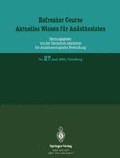Zusammenfassung
Die Überwachung des Patienten und des Narkosebeatmungsgerätes ist durch verbindliche technische Verordnungen, Empfehlungen der Standesorganisationen und die geltende Lehrmeinung vorgegeben (Übersicht 1.). Entsprechende Regelungen und Standards werden regelmäßig schriftlich in den Publikationsorganen der Standesorganisationen fixiert [1,23, 25].
Access this chapter
Tax calculation will be finalised at checkout
Purchases are for personal use only
Preview
Unable to display preview. Download preview PDF.
Literatur
American Society of Anesthesiologists (1986/1998) Standards for basic anesthetic monitoring. Approved by House of Delegates on 21.10.1986 and last amended on 21.10.1998
Bardoczky GI, Engelman E, D’Hollander A (1993) Continuous spirometry: an aid to monitoring ventilation during operation. Br J Anaesth 71: 747–751
Baum J (1998) Die Inhalationsnarkose mit niedrigem Frischgasfluss, 3. Aufl. Thieme, Stuttgart (ISBN: 3–13-717403–1)
Bhavani-Shankar K, Moseley H, Kumar AY, Delph Y (1992) Capnometry and anaesthesia. Can J Anaesth 39: 617–632
Caplan RA, Posner KL, Ward RJ, Cheney FW (1990) Adverse respiratory events in anesthesia: a closed claim analysis. Anesthesiology 72: 828–833
Caplan RA, Vistica MF, Posner KL, Cheney FW (1997) Adverse anesthetic outcomes arising from gas delivery equipment. Anesthesiolgy 87: 741–748
Cheney FW, Posner KL, Caplan RA (1991) Adverse respiratory events infrequently leading to malpractice suits. Anesthesiology 75: 932–939
Feigenwinter P, Wallroth CF, Gilly H, Zbinden AM (1996) Normen für Anästhesie, Intensivmedizin und medizinische Versorgungssysteme Teil 1. Anästh Intensivmed 11: 587–595
Feigenwinter P, Wallroth CF, Gilly H, Zbinden AM (1996) Normen für Anästhesie, Intensivmedizin und medizinische Versorgungssysteme Teil 2. Anästh Intensivmed 12: 644–653
Gehring H et al. (2000) The bias and precision of a new generation of pulse oximeter. Respir Care 45: 993
Gravenstein JS (1990) Gas monitoring and pulse oximetry. Butterworth-Heinemann, London (ISBN: 0–409-90261–6)
Konecny E, Hornberger C, Knoop P, Gehring H (1999) Probleme bei der Kalibration von Pulsoximetern. In: Wabnitz H, Klein KD (Hrsg) PTB-Bericht MM-9: Pulsoximeter — Messtechnische Prüfung von Medizinprodukten mit Messfunktion. Physikalisch-Technische Bundesanstalt, Braunschweig (ISBN 3–89701-442–4)
Kretz FJ (1998) Anästhesie, Intensiv- und Notfallmedizin bei Kindern. Thieme, Stuttgart (ISBN: 3–1310231-4)
Larsen R (1991) Intraoperative Überwachung der Atemfunktion. Anästhesiol Intensivmed Notfall -med Schmerzther 26: 481–482
Larsen R, Ziegenfuß T (1999) Beatmung — Grundlagen und Praxis, 2. Aufl. Springer, Berlin Heidelberg New York Tokio (ISBN: 3–540-65436–4)
Meriläinen PT (1990) A differential paramagnetic sensor for breath-by-breath oximetry. J Clin Monit 6: 65–73
Moller JT et al.(1993) Randomized evaluation of pulse oximetry in 20802 Patients: II. Perioperative events and postoperative complications. Anesthesiology 78: 445–453
Moyle JTB (1994) Pulse oximetry In: Hahn CEW, Adams AP (eds) Principles and Practice Series. BMJ Publishing Group, London (ISBN: 0–7279-0831–6)
Poirer MP et al. (1998) Utility of monitoring capnography, pulse oximetry, and vital signs in the detection of airway mishaps: a hyperoxemic animal model. Am J Emerg Med 16: 350–352
Pologe JA (1989) Functional saturation vs. fractional saturation: What does pulse oximetry read? J Clin Monit 5: 298–290
Rathgeber J (1999) Monitoring: Messmethoden. In: Züchner K (Hrsg) Grundlagen der maschinellen Beatmung. Aktiv Druck&Verlag, z(ISBN: 3–932653-02–5), S. 401–425
Rathgeber J, Züchner K, Kietzmann D, Weyland W (1995) Wärme- und Feuchtigkeitstauscher zur Klimatisierung der Inspirationsluft intubierter Patienten in der Intensivmedizin. Anästhesist 44: 274–283
Richtlinien der Deutschen Gesellschaft für Anästhesiologie und Intensivmedizin und des Berufsverbandes Deutscher Anästhesisten (1989). Anästh Intensivmed 30: 307–314
Roewer N, Thiel H (1999) Anästhesie compact. Thieme, Stuttgart (ISBN: 3–13-116581–2)
Schmucker P (1995) Qualitätssicherung in der Anästhesiologie. Anästh Intensivmed 36: 250–254
Siegel E (1997) Inhalationsnarkosegeräte. In: Kramme R (Hrsg) Medizintechnik — Verfahren, Systeme und Informationsverarbeitung. Springer, Berlin Heidelberg New York Tokio (ISBN: 3–540-60725–0)
Smalhout B, Kalenda Z (1981) An atlas of capnography. Kerchebosch-Zeist, The Netherland
Tinker JH, Dull DL, Caplan RA, Ward RJ, Cheney FW (1989) Role of monitoring devices in prevention of anesthetic mishaps: a closed claim analysis. Anesthesiology 71: 541–546
Weingarten M (1990) Respiratory monitoring of carbon dioxide and oxygen: a ten-year perspective. J Clin Monit 6: 217–225
Zander R, Mertzlufft F (1992) Überprüfung der Präzision von Kapnometern. Anästhesiol Intensivmed Notfallmed Schmerzther 27: 42–50
Editor information
Rights and permissions
Copyright information
© 2001 Springer-Verlag Berlin Heidelberg
About this paper
Cite this paper
Gehring, H. (2001). Monitoring der Beatmung während der Anästhesie. In: Refresher Course. Aktuelles Wissen für Anästhesisten. Refresher Course. Aktuelles Wissen für Anästhesisten, vol 27. Springer, Berlin, Heidelberg. https://doi.org/10.1007/978-3-642-56717-9_6
Download citation
DOI: https://doi.org/10.1007/978-3-642-56717-9_6
Publisher Name: Springer, Berlin, Heidelberg
Print ISBN: 978-3-540-41693-7
Online ISBN: 978-3-642-56717-9
eBook Packages: Springer Book Archive

